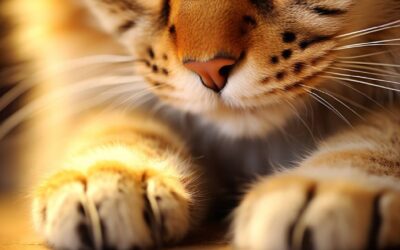Curious pet owners often wonder whether cats can enjoy ice cream’s sweet, creamy delight. Unfortunately, the answer is no. Cats are not allowed to eat ice cream. While cats may show interest in this frozen treat, it’s crucial to understand why it’s best to avoid sharing your ice cream with your feline companion.
We will help you understand why ice cream isn’t a safe choice for your cat, and the alternative treats you can explore that will keep them happy and healthy.
Is Ice Cream Safe For Cats?
While the image of a cat happily lapping up a bowl of milk is iconic and widely perceived as a natural indulgence for our feline friends, the reality is quite different. Do not feed your cat with ice cream; it harms your fur friend.
Cats, especially adults, frequently lack the enzyme lactase necessary to properly digest lactose, the sugar found in milk and dairy products. Given the risks, it’s best to steer clear of offering ice cream to your cat and opt for safer options that won’t compromise their well-being.
While there’s no specific test for lactose intolerance in cats, a diagnosis is often made based on the presentation of symptoms following the consumption of lactose-containing products and the resolution of these symptoms once lactose is eliminated from the diet.
Given the potential health issues associated with dairy consumption, it’s wise to consider cat insurance to help manage unexpected veterinary expenses.

Symptoms of Lactose Intolerance
Lactose intolerance in cats can lead to a variety of uncomfortable symptoms. If your feline friend consumes dairy products like ice cream, watch out for these common signs:
- Diarrhea: Frequent and loose bowel movements are a hallmark of lactose intolerance in cats. You may notice changes in the consistency and frequency of your cat’s stool.
- Abdominal Pain: Cats may exhibit abdominal discomfort, such as restlessness, pacing, or even vocalization due to cramping.
- Dehydration: Diarrhea and vomiting can lead to dehydration, so monitoring your cat’s water intake is essential if it has consumed dairy and is experiencing these symptoms.
- Vomiting: Cats with lactose intolerance often vomit after consuming dairy products. This can be distressing for both you and your pet.
- Flatulence: Excessive gas or flatulence can occur due to lactose intolerance, leading to discomfort for your cat.
- Lethargy: Cats with digestive upset may become lethargic or less active than usual as they cope with discomfort.
Symptoms can vary in severity, depending on the amount of lactose ingested and the degree of the cat’s intolerance.
Recognizing these symptoms of lactose intolerance early and taking appropriate action, such as discontinuing dairy consumption, can help alleviate your cat’s discomfort and prevent more severe health issues.
While ice cream is off-limits, you might wonder about other dairy products. Discover whether cats can eat yogurt to learn about safer dairy treats.
Alternatives to Ice Cream for Cats
Since most cats are lactose intolerant and cannot properly digest the lactose found in ice cream, offering them a dairy-based treat can lead to gastrointestinal upset. Learn about the FDA Regulation of Pet Food to ensure you’re providing safe options.
Several cat-friendly alternatives can provide the same joy without the discomfort. Here are some safe and enjoyable treats for your cat:
1. Homemade Frozen Broth: Freeze chicken or beef broth in an ice cube tray for a simple, hydrating treat. Ensure the broth is low in sodium and onion-free, as onions are toxic to cats. Some pet stores sell frozen treats made specifically for cats. These are formulated to be both safe and appealing for felines.
2. Lactose-Free Cat Milk: Cat milk products designed to mimic the taste of milk without the lactose can be a great treat. These are available in pet stores and are formulated to avoid digestive issues. For insights into how specific dairy components can benefit cats, check out how milk prebiotics are the cat’s meow, Illinois research.
3. Meat Purees: Pureed chicken or turkey can be frozen slightly to give a cool treat high in protein and moisture. Cat treat purees come in tubes, so you can just buy them in the cat food store. While not frozen, they can be chilled for a cool treat.
4. Watermelon: A few small, seedless pieces can be a refreshing and hydrating treat on a hot day. However, remove all seeds and offer watermelon in moderation due to its sugar content.
Adittion: A handful of frozen peas can offer a crunchy, cool treat. Peas are often found in commercial cat foods, so they’re generally safe for cats in small quantities.
Preparation and Serving Tips
Treats should only constitute a small portion of your cat’s diet. Even when offering cat-safe alternatives, moderation is essential to prevent obesity and maintain nutritional balance. Just like humans, cats can have food allergies. Introduce new treats slowly and watch for any adverse reactions. Ensure your cat has access to fresh water, especially when introducing new treats into their diet.
Sharing your ice cream with your cat may seem endearing, but resisting the temptation is best. Cats should avoid ice cream due to the potential risks associated with dairy, sugar, and artificial sweeteners.
Opt for safer alternatives to keep your feline companion happy and healthy. Additionally, understanding the potential for 527 Drug Residues in Milk underscores the need for careful selection of dairy products for pets.

FAQs
Can eating ice cream make my cat sick?
Yes, eating ice cream can make your cat sick, especially if they are lactose intolerant or sensitive to dairy. Symptoms may include gastrointestinal discomfort, diarrhea, and vomiting. Additionally, the sugar and fat content in ice cream can contribute to obesity and diabetes in cats. Balancing treats with a regular diet is key. For guidelines on meal frequency, see how often you should feed your cat.
Are there any safe alternatives to ice cream for cats?
Yes, safe alternatives can satisfy your cat’s taste for something cool and creamy without the risks associated with ice cream. Consider offering a small amount of lactose-free cat milk or making homemade frozen treats using cat-safe ingredients like pureed pumpkin or chicken broth.
How can I tell if my cat is lactose intolerant?
Signs of lactose intolerance in cats include gastrointestinal symptoms such as diarrhea, vomiting, and abdominal pain after consuming dairy products. If you notice these symptoms following dairy ingestion, your cat is likely lactose intolerant. Consult with your veterinarian for an accurate diagnosis.
Is it ever safe to give my cat ice cream?
It’s generally advised to avoid giving ice cream to cats. However, if you offer a tiny amount, choose a lactose-free variety and avoid flavors or ingredients toxic to cats, such as chocolate or xylitol. Even then, it should be considered a rare treat rather than a regular part of their diet.
What should I do if my cat accidentally eats ice cream?
If your cat accidentally eats ice cream, monitor them closely for signs of digestive upset or allergic reactions. Symptoms to watch for include diarrhea, vomiting, and lethargy. Offer plenty of water to help flush their system. If severe symptoms occur or if your cat appears to be in distress, contact your veterinarian immediately.






My cat goes wild for ice cream!